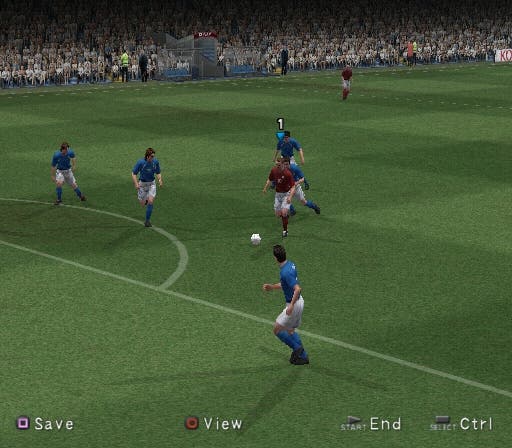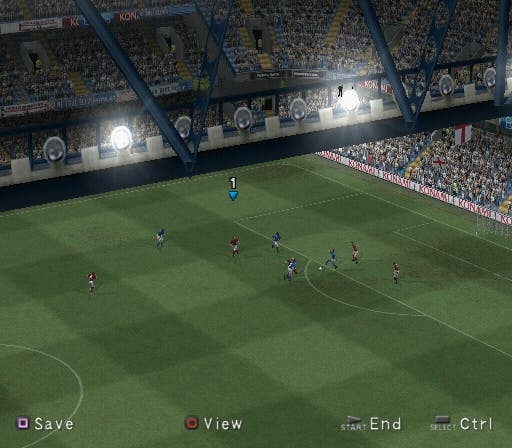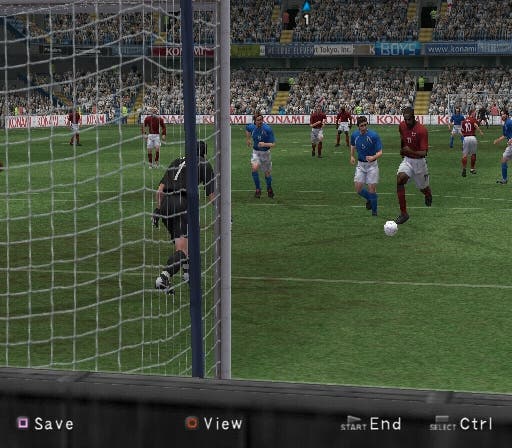Winning Eleven 7
In-depth impressions of the most important football game of the year.
Sweet mercy! Although the crooked-nosed duo of Townsend and Atkinson might not be long for our TV screens on a Saturday night, as I settled down at 10:30 for my customary weekly glimpse of Premiership football, it might as well have been Kirsty Gallagher and Helen Chamberlain swapping tragic clichés with Des "Mario" Lynam, I was so pleased to see them again. That's right. Wives, girlfriends, misguided children: it's time to pop outside, because the footy season's back! And, what's this? Why, it's Konami's twice-annual Winning Eleven update - the perfect accompaniment to any football event, and the technological precursor to Pro Evolution Soccer 3, which is due out in Europe towards the end of the year.
Liverpool one, Southern Softies nil

For anyone who hasn't caught other intermittent updates on our long-standing love affair with KCET's footballing opus, Konami has this habit of releasing new versions of the Winning Eleven series in Japan, then tweaking and expanding them for six months and releasing them in Europe under the Pro Evolution banner. Last time, they even produced a couple of tweaked derivatives for the Japanese market - a J-League branded edition of WE6 and subsequent to Pro Evo 2's debut, WE6: Final Evolution, which appeared on the GameCube alongside the usual PS2 edition. Unfortunately, that won't be happening with WE7 - there is no planned Cube version according to Konami representatives, not even in Japan - but the magnitude of changes to this year's formula is sure to have malnourished Cube owners contemplating Darth Vader's Toaster ever more seriously.
The thing that's most striking about Winning Eleven 7, beyond the routine menu paintjob, is the change to the way the ball moves. Whereas FIFA persists with its Teflon-coated pitches derived from NHL's ice rink tech, WE7 replicates the harsh reality of a normal playing surface, with bobbles, awkward bounces and irregular ball movement in many areas of the pitch. Of course playing surfaces vary, but as a result of the changes, running and passing quickly is not nearly as automatic as it was. Possession has become the key to success, and it's now more or less impossible to simply tear forward from a kick-off and regroup at the corner flag. Short of Michael Owen's post-jarring effort against the Romanians in '98, that simply never happens, and WE7 reflects that. What's more, the ball can even bobble just as you're about to sock it goalbound, leading to some embarrassing misses.
Speaking of which, it's perhaps regrettable that the age-old problem of the ball running out for throw-ins and corners, when players really look capable of controlling it, still persists - perhaps accentuated by the new playing conditions, but having seen Gilberto do it in rather hilarious fashion on Saturday we're prepared to let it slide. It doesn't affect the game too much - and in any event, throw-ins are a much more organic system this time. Instead of directing the ball to one out of one and a half options, WE7 gives you control of the receiving player and lets you run him into position to receive it. A big improvement.
Ball boys

Indeed, control of the ball and what you can do with it has been expanded considerably. Players react a little quicker to tweaks and will dive in at a split-second's notice to scoop the ball away from a lunging defender if instructed. The bouncing ball also plays a much larger role in WE7, with players more adept at trapping it and even flicking it over their shoulder, and volleys - at last - properly implemented. A couple of spectacular efforts even showed us how deflections have improved (on one occasion, a volley glanced off a Scottish defender's shoulder and wrong-footed the keeper on its way into the net) and how defenders react to loose balls by hoofing them clear, instead of performing a diving header, as often happened much to our disgust in previous editions.
With attacking as a unit now more crucial than ever, tweaks to the through ball system are also welcome, and it's now easier to curve the ball round a defender or lay it off successfully, although it's still quite possible to send the ball to completely the wrong player when another attacker seems wide open. Fortunately this time it's more likely that an attacker will be able to do something creative if he's on his wrong side - instead of just being good with one foot and rubbish with the other, right or left-sided players will attempt to play even necessarily wrong-footed shots with the preferred foot.
While the shape of the attacking game has changed significantly though, it seems fair to say that the defensive side - at least after the 15 or 20 hours we've dedicated so far - seems quite unrepentant for its sins. Holding a run modifier (R1 or R2) and holding X and square to send the controlled and nearest other defender respectively in chase of the ball is still the most effective way of pressuring players in possession, and holding square for an automated shadow whilst prowling round manually with your controlled player still yields a lot of good results. However closing down set-pieces is still difficult. More movement is permitted on corners, but what we'd like to see is a way of sending a player dashing from the wall on free kicks, or edging forward to test the referee's patience. The punishment for overstepping the mark could be a yellow card - and with referees now fully capable of sending more than three blokes off per side, it's bound to be a good incentive to stop. Speaking of refs, they've finally picked up on handballs and the advantage rule.
Football Italia

Oh and speaking of free kicks and set-pieces, WE7 continues to reward moments of genius, but doesn't just offer them on a plate. Free kicks have actually become more difficult, if you can believe that, and as someone who's invested tens of hours on this very aspect of the game, even I can't hit the target at speed ten times out of ten. The pace of the ball has been lowered slightly for WE7, so it's harder to get a well-directed ball to make a significant impact. It is possible to show off your signature skills a bit more in the centre of the field though, with a new 360-degree spin (you know, the one where Zidane stops the ball with his foot, rolls round the defender and pulls it past with his other foot) mapped to a 360 rotation of the right analogue stick, and there are bound to be other trick moves we haven't discovered yet.
Indeed, it's fair to say there's a lot of the game we haven't really touched on yet - largely thanks to the language barrier. We're told that there are options to control one player for the whole match (ala Namco's PSone title Libero Grande), to influence referee and crowd bias more specifically, to manually control the goalkeeper instead of just having him rush out by holding the triangle button, and to pull up a save-able action replay at any time. We've also yet to get to grips with the WE Shop, at which you'll be able to spend the "WEN" points you earn for every match you play (good news for people like me who pick up WE for a few exhibition matches every day of the year), or the revised Master League, which has been expanded to four geographically distinct divisions to make way for the 64 club teams on offer, including four fully licensed Italian clubs (a sign of things to come according to Konami).
On the whole and no doubt as you can tell, the sheer number of fine details worth acknowledging has well and truly swamped us. WE7 is a very complex beast, and one we won't claim to have covered comprehensively. However, it must be clear to any fan of the series - or football fan in general - that this now much heavier duty simulation is the most accurate recreation of the beautiful game to date. KCET has ironed out problems like players being knocked over all the time, the midfield pinball effect that plagued Pro Evo 2, the lack of fantasy club-versus-country options, and they've made it easier to get past the presentation hullabaloo and straight back to the action, whilst still maintaining the high standards of production that perhaps we expect from sports titles - the only thing we're not 100 per cent onside with yet is the TV interference effect on some of the action replays, but we're bound to warm to it eventually. Otherwise, the now proprietary engine (with RenderWare gone from the equation) has given KCET more license to play with intricate animation, and players are clearly who they are meant to be.
Feet of magnificence
Concerns that we have, and perhaps these are our only real concerns, are that the Japanese version of the game has an awkward stuttering problem on some older PS2s (and, we're told, particularly in widescreen), but Konami has acknowledged the problem and on pain of death promises it will be fixed in Pro Evo 3. And we're also disappointed that the summer's big transfers are not reflected here, with Beckham still a Man United player, and Chelsea's millions still unallocated. However there is a transfer engine and, given the "problems" as they are, it must be clear to everyone reading this that with a bit of tweaking under its belt, Pro Evolution Soccer 3 is set to replace breathing on our list of priorities by the end of this year. GOOOOAAALLL!!!

